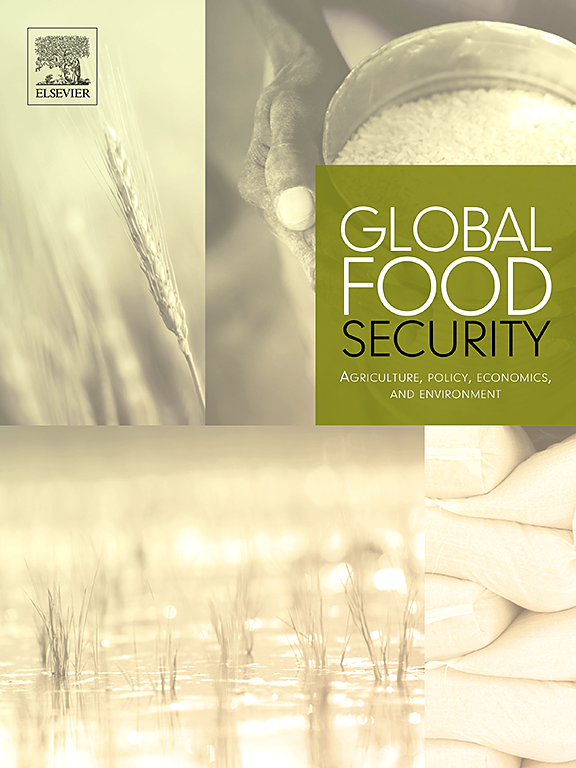农业劳动生产率的性别差距:非洲国家间的比较
IF 9.6
1区 经济学
Q1 FOOD SCIENCE & TECHNOLOGY
Global Food Security-Agriculture Policy Economics and Environment
Pub Date : 2025-07-19
DOI:10.1016/j.gfs.2025.100872
引用次数: 0
摘要
在撒哈拉以南非洲,妇女占农业劳动力的一半,她们的生产力往往因获得生产资源的机会有限和歧视性做法而受到限制。本研究使用来自世界银行生活水平衡量研究——埃塞俄比亚、马拉维、尼日利亚、乌干达和坦桑尼亚联合共和国农业综合调查的数据,考察农业劳动生产率的性别差距。采用瓦哈卡-布林德分解方法,我们分析了导致这些国家之间观察到的生产率差异的主要因素。我们的研究结果表明,男性管理的地块的劳动生产率最高,平均差距为33%,各国之间的差异从埃塞俄比亚的10%到乌干达的47%不等。研究结果表明,除了结构效应占主导地位的尼日利亚北部和乌干达,禀赋效应是所有国家性别差距的主要驱动因素。男性管理的地块生产率较高,主要是由于获得投入的不同,包括劳动和非劳动投入、管理和家庭特征。与共同管理的地块相比,研究结果表明,在尼日利亚北部和南部、埃塞俄比亚和坦桑尼亚,女性管理的地块存在细微的关系,但这种关系不显著,而女性管理的地块在乌干达生产力更高,在马拉维生产力更低。本文章由计算机程序翻译,如有差异,请以英文原文为准。
Gender gap in agricultural labour productivity: A comparison across African countries
In sub-Saharan Africa, where women constitute half of the agricultural workforce, their productivity is often constrained by limited access to productive resources and discriminatory practices. This study uses data from the World Bank's Living Standards Measurement Study–Integrated Surveys on Agriculture in Ethiopia, Malawi, Nigeria, Uganda and the United Republic of Tanzania to examine gender gaps in agricultural labour productivity. Employing the Oaxaca–Blinder decomposition approach, we analyse the primary factors contributing to the observed productivity disparities across these countries. Our findings reveal that labour productivity is highest among male-managed plots, with an average gap of 33 percent with variations across countries ranging from 10 percent in Ethiopia to 47 percent in Uganda. The findings suggest that the endowment effect is the leading driver of the gender gap in all countries except northern Nigeria and Uganda, where the structural effect predominates. The higher productivity among male-managed plots is primarily driven by differential access to inputs, including labour and non-labour inputs, managerial and household characteristics. Compared to jointly managed plots, the results suggest a nuanced relationship for female-managed plots with a non-significant relationship in northern and southern Nigeria, Ethiopia, and Tanzania, whereas female-managed plots are more productive in Uganda and less productive in Malawi.
求助全文
通过发布文献求助,成功后即可免费获取论文全文。
去求助
来源期刊

Global Food Security-Agriculture Policy Economics and Environment
FOOD SCIENCE & TECHNOLOGY-
CiteScore
20.90
自引率
3.40%
发文量
69
期刊介绍:
Global Food Security plays a vital role in addressing food security challenges from local to global levels. To secure food systems, it emphasizes multifaceted actions considering technological, biophysical, institutional, economic, social, and political factors. The goal is to foster food systems that meet nutritional needs, preserve the environment, support livelihoods, tackle climate change, and diminish inequalities. This journal serves as a platform for researchers, policymakers, and practitioners to access and engage with recent, diverse research and perspectives on achieving sustainable food security globally. It aspires to be an internationally recognized resource presenting cutting-edge insights in an accessible manner to a broad audience.
 求助内容:
求助内容: 应助结果提醒方式:
应助结果提醒方式:


